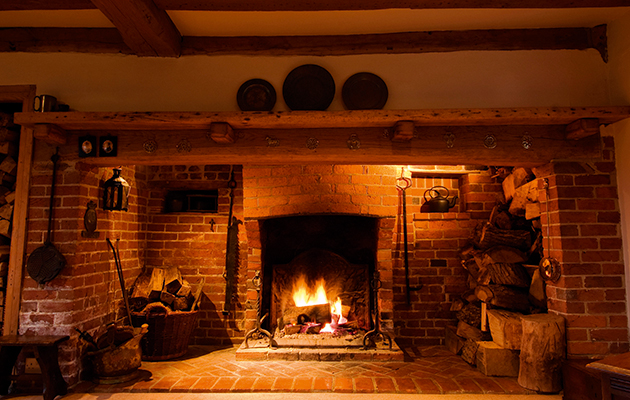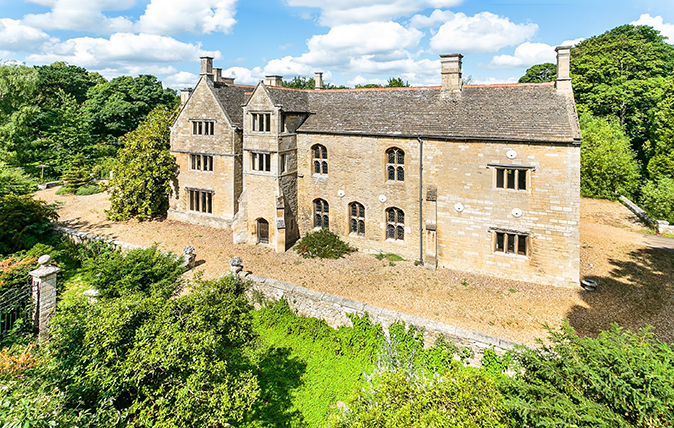How to heat your country house
How to heat your country house: a guide to the options.


How to heat your country house: a simple guide
Open fires Logs crackling in the fireplace, flickering flames lick the grate and the mellow fragrance of burning wood fills the drawing room nothing captures rural living better than a roaring fire. ‘I simply can’t imagine a property without it,’ says Philip Eddell of Savills’ country-house consultancy (01635 277709). ‘In Yorkshire, where I’m from, they say a fire is company. I’ve been without one for three years and am so happy to have it back.’
Fire, agrees interior designer Emma Sims-Hilditch (01249 783087) ‘appeals to all the senses: the smell the lightening up of the room as well as the huge log basket. When you’re coming back from a walk, there’s nothing more inviting than seeing the smoke gently coming out of the chimney.’
Burning logs in the hearth is perhaps the most spectacular way to enjoy fire in your country house. ‘It awakens primeval feelings there’s something satisfying in building and watching your own fire,’ comments Mr Eddell.
Wood-burning stoves However, notes Paul Chesney, managing director of fireplace and stove supplier Chesney’s, wood-burning stoves are more efficient at heating larger rooms (020–7627 1410). That’s why Angus Harley of Knight Frank’s country-house consultant arm recommends combining the two (01488 688511). ‘The drawing room could have an open fire to welcome guests, but the snug could have a wood burner to keep you warm when you’re studying or reading.’
Installing a new stove requires a little more thought and investment than lighting up your fireplace, but is well worth it. For starters, it’s import-ant to find a design that fits with your house. ‘Style is a personal choice, but I always prefer to opt for a classic look rather than an ultra-modern one for a traditional country house,’ says Mrs Sims-Hilditch. As ever, buy the best wood burner you can afford to ensure durability. Cast iron is better than steel, according to Mrs Sims-Hilditch, because it can withstand higher temperatures.
Choosing the right size for your new stove is also critical and Mr Chesney recommends that you seek professional advice about it. ‘People estimate far more heat and a bigger stove than they actually require. There’s a science to how big a stove you need, based on the size of your room, the type of heating you have already, the wall depth and so on.’
Sign up for the Country Life Newsletter
Exquisite houses, the beauty of Nature, and how to get the most from your life, straight to your inbox.
Both suggest that you should have an expert check whether a flue is required or, if the flue is already in place, whether it’s safe and lined. ‘Make sure you’ve allowed for ventilation for the stove as it requires a huge volume of air,’ Mrs Sims-Hilditch continues. ‘Some have a built-in air intake, which you can connect directly to an external air supply.’
Maintenance and safety Whether you opt for a wood burner or an open fire, you should follow basic maintenance and safety rules, especially if you live in a thatched house insurance companies such as NFU Mutual issue sound guidelines. At the very least, says Mr Eddell, ‘you should always have your chimney swept at least once a year plus have proper smoke alarms and fire detectors installed and, of course, you should never leave your open fire unattended’.
What you burn in your fireplace also makes a huge difference and not only because, as the poem goes ‘Ash new or ash old/Is fit for a queen with crown of gold’ whereas ‘Make a fire of Elder tree/Death within your house will be’. You should always use properly dry firewood that’s been well stored—Mr Eddell enthusiastically recommends Lars Mytting’s ‘brilliant’ hit book Norwegian Wood: Chopping, Stacking and Drying Wood The Scandinavian Way.
Underfloor heating Although fireplaces and wood burners add both warmth and atmosphere to a country house, you will obviously need to supplement them with a proper heating system and here, say agents, the preferences of buyers have changed significantly in the past few years.
Underfloor heating, in particular, has become hugely popular with buyers: not only does it free up space in your house, but, in addition, says Mrs Sims-Hilditch, ‘it provides gentle, consistent heat’. Not all properties are suitable, unfortunately, but, for those that are, your choice is between an electric and a water system. The former is easier to put in, but running costs can be higher than with a hydro-based system. Both require the right type of floor coverings (stone tends to work better than parquet, for example) and can be powered by conventional or Green energy sources.
Eco-friendly solutions ‘People are very conscious of energy-efficiency these days,’ says Nicky Craddock of Strutt & Parker (020–7318 5187). ‘They ask about heating costs and often have higher expectations about all specifications.’
Your property’s nature, architecture and history will dictate which Green heating option is best for you. Ground-source heat pumps, which transfer heat from the ground, are suitable for most country houses and, although they may initially be expensive to install, can bring significant savings. ‘If you have sufficient space, you should definitely look at ground-source heat pumps because, once installed, they’re easy to operate,’ explains Mr Eddell. ‘They’re great for supplementary heating and are particularly good for swimming pools.’
Biomass boilers which burn (sustainable) logs, wood pellets or chips to power heating and hot water can also ensure substantial savings over conventional solutions while reducing the negative impact on the environment. ‘Wood- or wood-pellet-burning boilers give you renewable, clean energy and can be installed in outbuildings,’ says Mr Harley.
However, because the ideal heating solution for one country house may be the worst for another, it really pays to research several options thoroughly and talk to energy professionals. ‘Don’t just go to the first consultant you come across,’ warns Mr Harley. ‘Take advice from people with the right track record.’
When assessing your investment, don’t forget to factor in ease and cost of maintenance, as well as installation and running costs. ‘I’d be wary of extremely complex systems,’ cautions Mr Eddell. ‘If the supplier goes bust, it could end up being expensive. My preference is for established systems with simple, robust technology that a lot of people can fix if something goes wrong.’
Whichever solution you opt for, concludes Mr Harley, make sure you’re able to control room temperature at radiator level, as well as having a central thermostat, otherwise heating your country house could quickly turn into an enormously expensive operation.
You should also consider insulation: proper shutters are surprisingly effective, says Mr Harley and investing in clever software that anticipates temperature changes based on the weather forecast and adjusts your thermostat accordingly.
** Read more on country houses and search country houses for sale
Carla must be the only Italian that finds the English weather more congenial than her native country’s sunshine. An antique herself, she became Country Life’s Arts & Antiques editor in 2023 having previously covered, as a freelance journalist, heritage, conservation, history and property stories, for which she won a couple of awards. Her musical taste has never evolved past Puccini and she spends most of her time immersed in any century before the 20th.
-
 The King's favourite tea, conclave and spring flowers: Country Life Quiz of the Day, April 22, 2025
The King's favourite tea, conclave and spring flowers: Country Life Quiz of the Day, April 22, 2025Tuesday's Quiz of the Day blows smoke, tells the time and more.
By Toby Keel Published
-
 London is the place for me* (*the discerning property buyer)
London is the place for me* (*the discerning property buyer)With more buyers looking at London than anywhere else, is the 'race for space' finally over?
By Annabel Dixon Last updated

